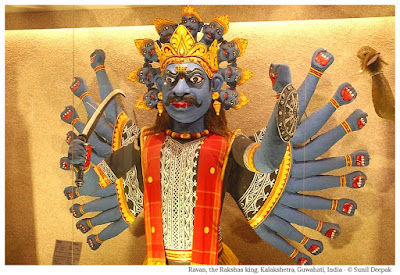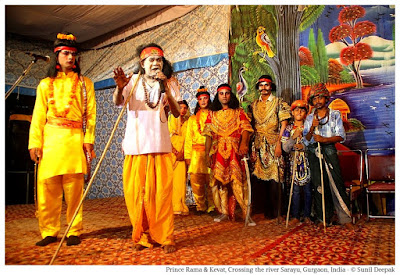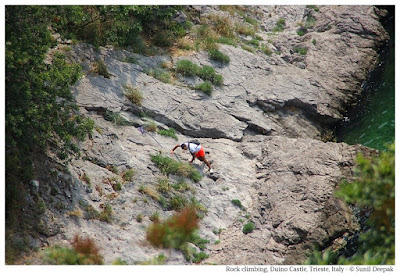Rama's Story
The central theme of Rama's story is that of obedience and respect of the parents. The widespread enduring popularity of this story after so many centuries continues to surprise people.
Rama was a prince, the eldest son of king Dasharath of Ayodhaya in north India. He married princess Sita.
King Dashrath had three wives. Kekayi was his youngest wife. She asked the king to send Rama to exile for 14 years and in his place, install Bharat as the king of Ayodhaya. The old king was bound to Kakayi by an old vow and was forced to accept her request, even if he felt that it was unjust.
Rama assured his father that he will obey and live in exile for 14 years. His wife Sita and another borther, Laxman, decided to follow him in his exile. The old king died. Bharat, who was away and did not know what had happened, came back to Ayodhaya and discovered that he was supposed to be the king. He refused and instead went to the forest to seek Rama and asked him to come back.
However, Rama said that he had promised their father to live in exile for 14 years and he can not break his promise. Thus, Bharat went back to Ayodhaya and governed it as a caretaker king, waiting for Rama to come back.
Other Characters from Ramayana
While the images above are about Prince Rama, his Sita and his younger brother Laxman, below you will find some images of other characters in Ramayana.
Rakshas king Ravan: People unfamiliar with Indian way of reasoning, think of the Ravan as a kind of demon. However, in Ramayana, Ravan is also a learned Brahmin and there is a tradition to praying to him. The image of Ravana below is from Kalakshetra in Guwahati (India).
Here is another image of Hanuman from a Kathakkali performance in Bologna (Italy).
The oral history traditions of India credit a sage-poet called Valmiki for having written the first version of Ramayana. Valmiki's Ramayana was written in the ancient Indic language Sanskrit and has 24,000 sholokas (verses) divided into seven chapters.
Another version of Ramayana written in Avadhi, a dialect of Hindi, in the 16th century called "Ram Charit Manas" made it more accessible to common persons. This was written by Tulsidas Goswami. It is commonly read aloud in village squares and along the rivers in different parts of India. The image below is from Varanasi where Ram Charit Manas is being recited on the banks of river Ganges.
Outside India, Indoensia has Kakawin Ramayana, Thailand has Ramakien, Cambodia has Reamker, Laos has Phra Lak Phra Lam, Myanmar has Yamayana and Sri Lanka has Janakiharan. In Nepal, the Dashain festival celebrating the win of Rama and the defeat of Ravan is the most important religious event in their calendar.
In Thailand, the kings take on the name of Rama and the ancient capital of Thailand was called Ayutthaya. Many Asian countries have living traditions of presenting the Ramayana stories through dance, theatre, puppets and other art forms. The image below has Rama, Sita and Laxman from Thailand.
The tenth day of Dusshera, coincides with the death of Ravan, and is celebrated as Vijaya Dakshmi. Twenty days later, the return of Rama to his kingdom in Ayodhaya is celebrated as Diwali, the festival of lights.
Even the other Indic religions, including Buddhism, Jainism and Sikhism include references to the stories of Rama. For example, the stories about Buddha describe him as a prince of Ishvaku dynasty, the dynasty of Rama in Ramayana.
Perhaps the first oral traditions of Ramayana had started when the urban settlements and agriculture were still new and the memories of ancient hunter-gatherer societies was still alive. Rama's exile in the forest to the hunter-gatherer way of living must have touched deep feelings of identification in the persons.
Conclusions
As a child, I grew up in the narrow streets of Old Delhi. Reading the stories of Ramayana in a children's magazine called "Chandamama" and listening to the chowpais (verses) of Ram Charit Manas in community readings in the neighbourhood.
Why did Rama's story had such a deep impact on the communities in India and other Asian countries? One of the reasons could be that its values - love and respect for the parents, obedience, respect for brothers, were all values necessary for the survival of agricultural societies based on extended family systems. Thus, the story found acceptance in different countries of Asia. (Another image of Thailand Ramayana below).
Ramayana and the story of the prince of Ayodhaya has survived for centuries, growing like a tree with a common root but branches going in different directions.
***

































































